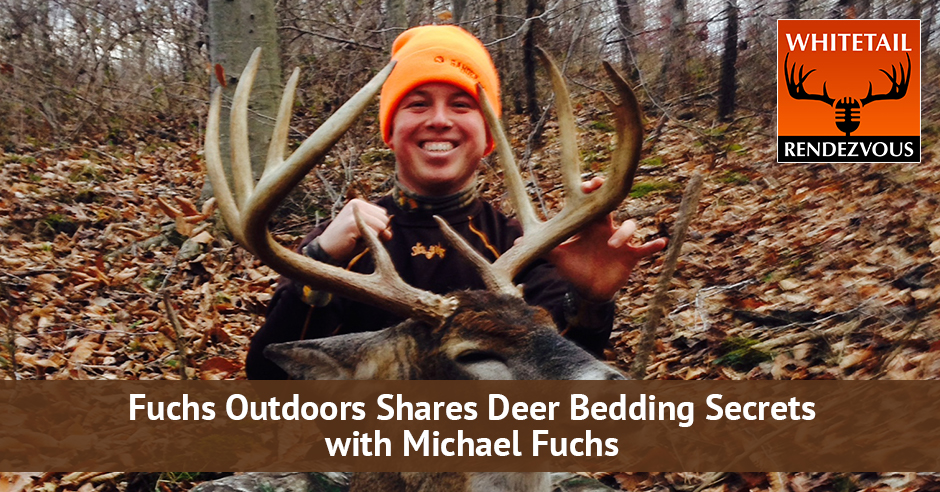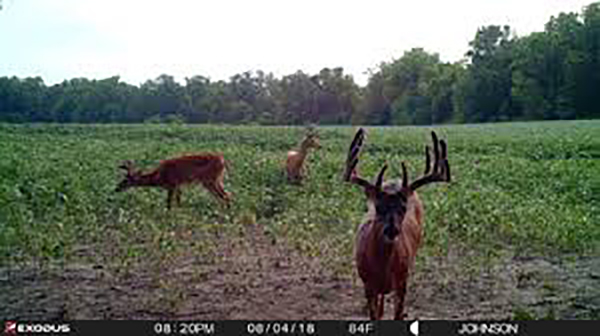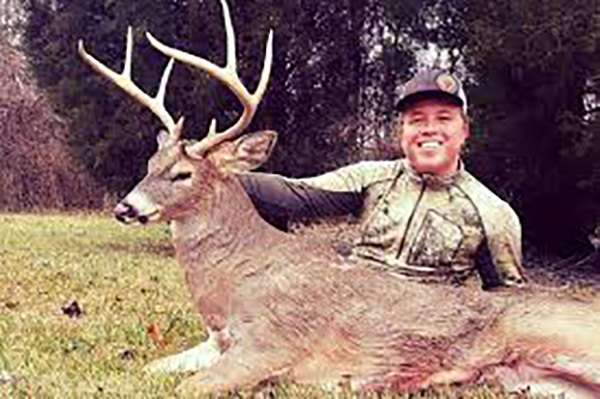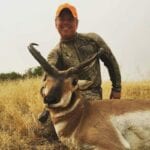
—
Listen to the podcast here:
Fuchs Outdoors Shares Deer Bedding Secrets with Michael Fuchs
We are heading to Southern Indiana and Michael Fuchs is our guest. Michael does some work over at Dan Johnson’s Sportsmen’s Nation, where he’s a blogger. For his day job, he works at Reynolds’ Aluminum, where he’s a mechanical engineer. Michael, welcome to the show.
Thanks for having me. I appreciate it.
I get excited when I see young guys who are as passionate as I am about whitetail deer. We traded some emails and you came back with some insightful things. We have to give a shout out to The Hunting Beast, Dan Infalt, because he taught me so much. He’s helped you along the way so you’re taking his ideas and making your own. Let’s talk about your hunting tradition and how you got started in hunting.
I want to give credit to Dan as well before we get started. Without him, I wouldn’t be where I am. I started listening to him in 2014 and talking to him. He responded to me multiple times and we had some discussions. I want to say, “Thanks, Dan.” I was born and raised in Southern Indiana. I lived here all my life. My grandpa got me started off into hunting when I was old enough to carry a gun. He was reaching out to my mom, he was my mom’s father and started to take me squirrel hunting. My uncle took me to my first deer hunt ever and killed a six-pointer with him. It was my first season and I got pretty hooked after that. I think I was about twelve years old or so. I’m older now and ate up with it. It’s eat, sleep and live whitetail land.
How did you get tied up with Dan Johnson at Sportsmen’s Nation?
He reached out to me. I talked to him about doing a podcast and he was looking for some bloggers. I don’t know if he reached out to me through Facebook or Instagram, one way of the other, but he got in touch with me. I wrote a couple of articles and did a podcast. I talked to him via email. He reaches out to me if he needs some materials or content from me.
How many articles do you have up?
I’ve written four or five articles for Dan. I do a lot of writing personally. I’ve brought out a ton of content I’ve written for myself that hasn’t been released. I share it with some close friends and my hunting partner.
Deer are only away from bedding area 5% in any one day. During the rut, all bets are off. Think hunting bedding areas to dirt nap a mature buck. Share on XIf somebody went to your Facebook or Instagram page, can they read anything you’ve written?
On my Instagram page, there’s a link in my bio. You can get it on Sportsmen’s Nation to access. When you go to the Sportsmen’s Nation About on the top, you can go underneath there and locate my name. All of the articles that I have submitted to Dan are there.
It’s great to see a young guy like yourself so passionate about hunting whitetails and a student of the game. That’s one thing I learned early on is that you never know it all. Every single year, I get schooled by one or two of my target bucks. I am hoping to close the deal. I’ve got one deer I’ve been hunting for three years and I hope I can get close to him. My buddy missed him. He shot over his back with traditional gear. He didn’t remember, he got too excited. He’s a good shot inside of twenty yards.
We got three deer in that one swamp area surrounded by ag. It was a perfect day at Infalt property. We know where they are, where they bed and everything about them. It’s getting there in the right place that’s extremely difficult. Enough about me, let’s get back to Michael. When I asked you the tactics that you wanted to talk about, the first one we are going to talk about is the transition from private hunting to public hunting. How did that happen? Why did it happen? Tell me about it.
In 2014, I took a job up north working for Honda at the Civic manufacturing plant. I’ve been hunting in a private farm my whole life in Southern Indiana. I got up there and started to hunt in some areas. I was living up there and I had a successful season that year. In 2014, I killed my target buck. That was the year I started talking with Dan. At the end of that season, a farmer back here at home reached out to me. A lot of the private lands are getting leased up. That’s fine, I understand. There’s business to be made and the farmers have to pay their bills too. He reached out to me and said that it was going to cost a couple of thousand dollars to continue hunting that farm I grew up on. I thought about it and talked with Dan. After having a successful season doing my own thing and getting away from my comfort zone, I made the decision not to continue hunting in that private farm.
From there on, I started hunting on primarily public land. It has been that way ever since. Most cases, I like public land over private. The more I find out, the more I hunt it because you can get into such big timber. I learned that the more secluded I get, the more these whitetails, specifically big mature bucks, are creatures of habit especially in terms of bedding. The further away I get from the beaten path, the less pressure that’s been on these whitetails, the more consistency that I am seeing as far as their bedding behavior. A lot of this stuff goes back to Dan’s tactics that I have been able to implement myself. It’s been my success over the past years.
When you think about hunting in public land, tell me your process of how you figure out where the bucks are bedded on property that’s your first time in? What does that look like?

I have a ton of people reach out to me and there’s nothing more I enjoy than sharing this stuff. First and foremost, you have to read a topographical map. It’s a must. You have to know how to read contour lines and you have to be able to break a map down. That’s the number one thing. Working from there, the number one thing is for anyone to learn buck beddings specifically in Hill Country and the deep stuff I am hunting, you have to learn how to read a topo map. I spend 90% of my time scouting. 90% of my efforts towards deer hunting starts with the map.
When you’re looking at a topo map, contour lines sometimes get close together and sometimes they spread out. You can read a lot off it. What are the three things you look for when you are looking for a bedding area for a mature buck?
If I am looking in deep timber, I am looking for ridges. Anytime you have a change on elevation, you’re going to have tight stacked lines. Those tight stacked lines are going to be leading up to a ridge top. Follow those lines up to where it starts. Open it up and the lines become a little more spread out. That’s going to be the top of the ridge. If you want to get into more detail, I am looking for leeward ridge sides. When I say leeward, I mean the direction the wind is coming across. I primarily target south-facing slopes. I am looking for the contour lines that are stacked up or confirmed south to north. That leads my tactics towards buck bedding and how a buck’s bed will change in relationship with the wind. If the wind is coming from the north, that buck is going to be bedded in the south-facing slope every single time. I generate multiple scenarios for multiple different areas in multiple different of wind. The wind acts as a compass for me as to where the bucks going to be bedded at.
Do you use Google Earth or onX Maps?
I use onX maps. When I first got into this, I was big on Hillmap. I hunt so much in public land that to get property boundaries, I was constantly going back and forth from DNR page to get private boundaries versus HillMap, which was going to show contour lines versus satellite imagery. On my onX, I’ve got all my public and private property lines. They’ve got the hybrid option on there where you can connect your topographical contour lines over your satellite imagery. I am always swapping back and forth between my hybrid map on my onX and my topo map.
Michael is a 365 hunter. His attention to details, he can do it right at his desk. He can do it at home, on his lunch hour or wherever because he has digital onX maps and paper topo maps. The thing that he mentioned that you have to pay attention to is how the bucks use the wind and how they bed in relation to the wind. Do you look for saddles?
I definitely look for saddles. Saddles are more lenient to me than my rut hunting tactics. I like to target saddles whenever I’m rut hunting. What I call rut hunt changes my tactics up a little up versus early season. Saddles are good travel area for bucks. Let’s say I have a wind out on the north and I have a south-facing slope on a saddle where I got ridge top on the left of that saddle and a ridge top on the right. I’ve identified doe bedding on top of that ridge. If I have a north wind coming from across that ridge and that upper third in that saddle, what I named off is your benchmark rut hunt country.
Big mature bucks are creatures of habit especially in terms of bedding. Share on XWhat about if you get into ag land? It might be a little hilly but it’s not as hilly as maybe you’re expressing. Or you get into the swamps which have some elevation but they’re relatively flat. How do your techniques apply there?
Most of the public land I hunt is strictly hill country. A lot of it is leading into private agriculture areas. I have picked up a few private farms in the past few years. I killed my Kentucky buck on opening weekend on a private farm. I videoed my hunting partner killing our other target buck on opening evening. The bedding is definitely different on private farms, tight parcels. I’m seeing the buck’s bed wherever they can get seclusion. Wherever there is no pressure existent is where they’re going to bed. You have to learn the property to identify that. First in hill country, I am seeing consistent leeward ridge bedding. On upper third usually but not always on a point.
On private farms and not so hilly areas, I am usually seeing bedding in isolation wherever the buck feels like he’s safe. At certain times of the year, it’s usually on the edge of a food source. I still do see that they want the wind in their back and be watching that food source. Even if it is a flat land, they’ll lay there and pit their eyes on that field. Whether it’s beans, alfalfa or whatever they’re eating, they’ll watch it all day and have the wind on their back. When they get up that evening, they know that they’re safe to enter that field that night. Everyone says that the pressure pushes them back off their summer bedding. I don’t disagree that it influences it, but I think it’s more of their natural cycle when that testosterone starts kicking in. The nature cycle of a mature whitetail buck is to feed all summer and prepare for the focal point of their life which is to rut. At that point, they’re ready to transition back to cooler areas, get back in where they are comfortable living at until the following spring and summer
You mentioned core areas. Is that the same as home range?
I would call it a home range. When I say core area, I am more referring to bedding. A lot of the deer I am watching right now, in the evening they’re bedding on the edge of the food source. I’ve already identified the hill countries and the ridge terrain through my winter and spring scouting and topo scouting of where they’re living once they make that transition. I give it a 1.5 mile radius from the food source. I would call that the home range and work from that food source back into their bedding. The time of year is going to dictate what part of that home range are they spending their most time.
It goes back to their first Wired to Hunt podcast that I was listening to. It was Dan Johnson and Mark Kenyon. They brought Dan Infalt on. He made the statement that mature bucks can spend 95% to 99% of its daylight life laying in bed. When you think about that, it only gives you 5% or less of an opportunity to kill that deer, to kill that animal while he’s on his feet during light hours. When I heard that, it opened my eyes. I must have replayed that 100 times. I think it might be podcast number 37 in the old one Wired to Hunt podcast that I used to always listen to.
The only time they spent more on their feet is during a rut. If you disagree or agree, reach out to me at WhitetailRendezvous@Gmail.com. I would say that the bulk of his day time activities on his feet is from October 20, November 10 or a little bit later. For about 30 days, he’s moving because that’s what he was born to do, breed. Propagate the herd. If you want to go out and shoot at deer, that’s probably the best time to do it. If you pick the right funnel and pinch points, we know the deer are on their feet looking for bedding areas. Your thoughts?

I don’t disagree with you. I’ve got a love-hate relationship with the rut. If I have a particular animal that I am interested in killing, it gets to be the rut. I haven’t killed it yet. You roll your dice as to where he’s going to travel, where he is going to end up or getting back to the buck beds. The hunting tactics in identifying these core areas and down to the bedding area. I’m laying in their beds in the winter and spring and figuring out why they are here, when they’re here and when they are going to be here during the season, whenever I have the opportunity to kill them. When the rut rolls around, you can almost throw that to the side. My tactics are going to be completely different and there’s no telling she’ll end up stumbling upon during the rut. You know his bed and where he lives. He might get killed a mile down the road by a neighbor, a thirteen-year-old on his first day of hunting. That’s his luck on the draw. That’s the hate part of it. There is nothing better than that action at time of the year for being in the woods. It’s magical.
You actually go and get into the beds of the bucks that you know are around, is that correct?
Yes.
Why do you do that?
During my winter or spring scouting, it’s the only time I was going into the bedding areas until season comes or whenever I am going in to kill an animal. I want to know exactly why he’s there. I want to know exactly where he’s going to travel when he gets up and leaves that bed. I’ve been successful with this tactic. I like to get into that deer’s mind and I want to know why he’s bedded there. I want to know when he gets up and the next 100 yards he takes are going to be in what direction. In a few months, I’ll be in that direction in a tree trying to put an arrow in him. That’s why I do that.
You see a buck bed and there is no snow on the ground. How do you know which way he gets up and moves?
It depends on where the bed is at, first off. If it is on a point, I’m laying down on that bed and looking up over the point. Usually, you’ll find some signs around there whether it’s a rubline or a scrape. I look up down that point, I see a rub and I know it’s a rub made from a buck that’s laying on that bed. I see a scrape down the point. I put that picture together as far as where he’s going to travel when he leaves there. Always have a point B in mind. Point A is always the bed and point B is where that deer is going to travel to, whether it’s to go feed or congregate with the rest of the herd. If this is on an ample third of your standard ridge, getting in that bed and reading that sign coming out of that bed, I am always looking for tracks. If I’ve got a bed that’s five to six feet around and 50 yards from it going down the creek was a track I can’t fit my hand in, that’s four fingers wide, I know it’s that animal. I document that and after that, I’m looking for a tree to get in. I’ll mark that tree. I have twenty different scenarios like this by the time April hits. All those are bucks that I’ve identified. Some of them I might have laid eyes on. Some of fondest ones are the ones I haven’t laid eyes on. I know it’s a big deer and I’m going in and hunt them because its rubs are as tall as my neck or I can’t lay my hand on his tracks.
I’m thinking about the farm that I hunt and some things are dropping into place of where I’ve seen deer. The one thing I have is that the one key in the area is most favored is in a south facing slope. It was logged so it’s terrible.
There’s nothing better than seeing someone passionate be successful. Share on XIt would change the game when they start there.
Even when we have snow on the ground and you can track them, you can’t go in there. It’s not going to happen. If someone wants to reach out to you, what’s the best way for them to touch base with you and say, “You’re bringing up some things that I never thought about. Can we talk?”
On my Instagram page, @FuchsOutdoors. Even in my deer-related posts I always mention, “Shoot me a message.” I’ve had numerous people reach out to me. There’s nothing more I love than seeing someone passionate be successful. When I get that message, phone call, text, picture, whether it’s scouting or they get a good one on the ground, it’s great. There are some people I text and talk to. Instagram is the best way to reach me. Nothing’s changed here. I don’t advertise everything, but I can guarantee that there’s not a day goes by I’m not spending time and effort into the deer.
Winter and spring, you zeroed in on a few bucks. You know where they are, you know where they’re living and you know where your tree is going to be. What do you do in the summertime when they transition to grocery time and they’re up on their feet? They lay down in alfalfa basically all night. They lay down, go back and eat. Tell me about that transition.
This time to the year is the best time in the State of Indiana. I’ll go out spot lighting at night. I’m either looking at food sources within that home range where I’ve identified the core areas where bucks are bedding. In certain areas, I know the exact deer that’s bedding there. The other ones, it’s a sign that I found there in the winter and spring. It’s not an area I circled back around to the summer to observe. There are new areas back in the winter and spring that I was in deep ridges, hill country and on public land where I identified good buck bedding. Now, there are food sources that they’re living on and feeding on within a quarter mile to a mile, how far it might be.
I got the opportunity to see what animal might have been responsible for laying that bed. I’m getting to lay eyes on him and knowing what I’m getting into going into the season when they get back to that area where I need them to be to get killed. It’s a great time of year to get out there. There are also nights where I’ll go out and glass a new area. I usually don’t waste any time on areas unless it’s somewhere I’ve got potential or capability of hunting. Most of my time is spent on public land. I’m trying to find nothing but food source within that home range out into a mile and a half of that public land and I’ll be able to hunt.
Let’s talk briefly about your use of trail cameras.

I’m no trail camera guru by any means. As far as a standard camera goes, I run more cameras in the winter and spring, after season than I do anytime to get in inventory of bucks and known areas that it survived going into the following season. I will say that trail cameras, if they’re used correctly, can change the game. The bucks that my partner and I killed in Kentucky on the opener, without that cell camera, we’re running through snow with trophy cameras. I was able to send pictures from there where we were hunting. Without that camera, we wouldn’t have known that animal was there. You’re getting live data and inventory without stepping foot in that property, which was huge.
There are multiple areas going into Indiana season where we know bucks are living. We’ve been watching them feeding. We know the core areas where they’re going to move into. We’ll be utilizing cell cameras for this transition and getting an idea on when they’re back in their core bedding on where we need them to be to get them killed. If I put a cell camera up for that use, maybe I’ll do great at maximum. I know he’s going to be traveling through. I’d like to do that before he makes that transition back there. At that point, it’s just waiting. If I get a picture of them and it’s a north wind south facing slope on a point, he’s going up there at 4:00 AM or 5:00 AM to lay on that bed. I know right where I’m heading that evening, assuming that the conditions stay right.
If you’re that close, can he see you because you are approaching him from below to get up into your tree? You’re hunting on his bed and he’s got the advantage of height. Is that correct?
That goes back to why I lay on those beds to get that vision, “How far can he see?” There are certain beds looking downhill where a buck might able to see 500 yards. There are other scenarios where he might only able to see 100 yards. That’s going to dictate how far I am going to push it. I’d be lying if I said that I haven’t gone in these situations and jumped a deer I was trying to kill off, because I have done it before. Fortunately, when you’re going in like that, wind is always at your face. I jumped some big deer up and had him come right back when they haven’t winded me. If they don’t know what you are and you run them out, they don’t smell you because they don’t detect that there is human presence there. Don’t give up. They’ll most likely be back, which is the beauty of going in upwind like that. To get back to your question, there are some bucks I’ve watched get out of bed. There are others I’ve known that have traveled a couple hundred yards to get to where I have killed them. You are trying to get as close as you can, but you don’t want to get close enough so they can see you. I want to be outside that. If I know he can see in 100 yards, I’m going to be 105 yards out from him. I’m going to take my glorious sweet time getting set up and be as quiet as I can. Any wrong move or any noise, whether it’s a tink of a tree stand or you drop something, the game can be over right there. Time sure flies whenever we’re talking about whitetail.
I look forward to more conversations because we’ve got a lot to talk about. Why don’t you recap the most important things a person can do to target that mature buck?
First off, you have to find them. You have to know that there is a big deer in the area. If there is not a big deer, then you’re not going to kill a ghost. To stem off that, knowing those topological maps and being able to read contour lines is huge if you’re hunting country bucks like I am. I would say those are the most important things there. There are so many factors. The list goes on.
The game never stops. I never stop learning and you never stop learning. I hope my audience never stop learning. Michael, it’s been a joy hanging out with you a little bit. I hope my travels will take me to Southern Indiana. I’d love to spend a day with you. We will compare notes and keep building our relationship. On behalf of hundreds of thousands of readers of Whitetail Rendezvous, thank you so much for being a guest.
I appreciate it and I look forward to our friendship.
Thank you.
Important Links:
- https://SportsmensNation.com/podcasters/michael-fuchs
- https://SportsmensNation.com/podcasts/summer-scouting-buck-beds-hunting-strategy-with-michael-fuchs
- Sportsmen’s Nation
- The Hunting Beast
- Instagram – Michael Fuchs
- onX Maps
- Wired to Hunt
- Podcast number 37 – Wired To Hunt previous episode
- WhitetailRendezvous@Gmail.com
- @FuchsOutdoors – Instagram
About Michael Fuchs
 He is a native of Southern Indiana and he live for the outdoors.
He is a native of Southern Indiana and he live for the outdoors.
His Grandfather introduced him to hunting at an early age and his passion has escalated from there.
He is a featured blogger form Dan Johnson’s Sportsman Nation.
He is a Mechanical Engineer for Reynolds, where he design the equipment and processes that manufacture Reynolds Wrap Aluminum Foil.
